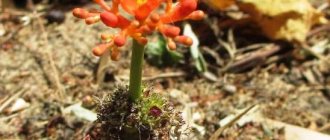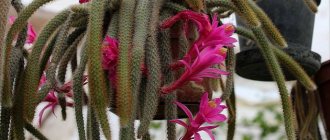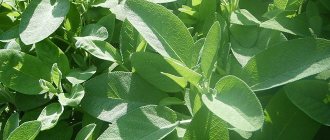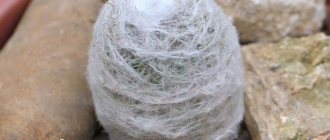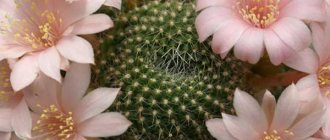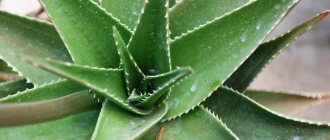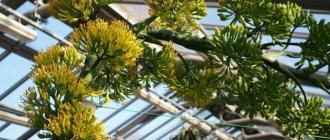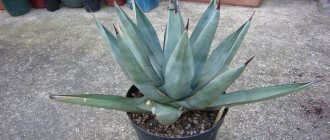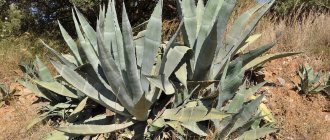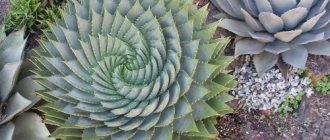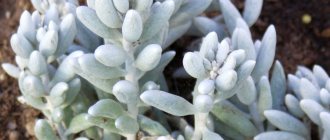Since the discovery of the New World, the indigenous fauna of the agave flower has changed significantly. Europeans were able to tame it purely for decorative purposes, developing varieties that were very miniature and capable of living on the windowsill of any home.
The healing properties of agave (its juice) have been known since ancient times. The natives used it to treat wounds and many diseases. Traditional medicine still uses agave for medicinal purposes. In Mexico, a special variety of it - blue - is specially grown on large plantations, making alcoholic drinks from it - the well-known and popular tequila around the world and some little-known alcoholic liqueurs.
Description and features of the genus Agave
The genus Agave unites the subfamily Agavoideae (Agave) from the Asparagaceae family. It lists about 400 varieties of crops that are widespread in Central America, the southern regions of the United States, and the Caribbean islands.
Agave in natural conditions
All species of the genus Agave are characterized by large leaves that form rosettes with a diameter of 16 cm to 6 meters. The leaves of each species vary in size, shape, texture and color. As a rule, in most varieties of Agave, the edges of the leaf blades are covered with spines of different sizes, and at the tips of the leaves there are hard, sharp spines. Although there are types of succulent without thorns with soft, leathery leaves. The appearance of crops, based on the variety, may differ significantly. The shade can be green, bluish-green, gray, and there are also varieties with stripes of white or yellow.
Many members of the genus are accustomed to growing in the wild, mainly in desert and highland areas. Agave roots allow the plant to fill with moisture from various sources - rain, condensation or dew.
Agave flowers
Seeing this beauty bloom is a rare occurrence, as it happens once every 30-60 years. In this case, a long arrow is formed, on which a spikelet or panicle grows. In some species the peduncle can reach 10 meters. Flowering duration is 24 hours. In this short time, you can admire more than a hundred miniature yellowish-green bells. Most Agave species are monocarpic succulents. After flowering and fruit development, the central rosette dies. That is why it is believed that the Agave plant blooms once in its life.
Initially, crops appeared in Europe in the 2nd half of the 16th century, gaining wide popularity as exotic ornamental plants. Now they can be grown on the streets, in gardens, in greenhouses, and also indoors (depending on the region).
Agave is often confused with cacti, Aloe and other crops. Although they are characterized by such a feature as succulence (collection and retention of moisture in various plant structures), each group belongs to different families. Cacti and sedums are classified as Eudicots, while Agave and Aloe are classified as monocots. Agave is often compared to Aloe, but they are also representatives of different families. Aloe belongs to the Asphodelaceae family.
What is it like?
Arid lands are the natural habitat that gives agave its moisture-filled, succulent leaves. Basically, many species of this interesting representative of the fauna have absolutely no stem and grow like a hefty bush. Their long, spine-edged leaves, growing from one powerful rosette above the ground, can reach a length of more than a meter.
Wild varieties of agave are flowering ones. Some decorative varieties lack this. Not every agave placed in a pot can please its owners with beautiful flowering.
Under natural conditions, after 20 years, the plant throws up a long (about 15 m) flowering stem with small flowers. Then it dies, leaving several near-root shoots.
Description of common species of the genus Agave with photos
We offer a brief look at the most popular species of the genus Agave with a brief description.
Agave filamentous (filamentous) or filifera (Agave filifera)
It is distinguished by thin leaf plates (up to 2-4 centimeters). Their length is up to 30 centimeters. The shade is the original matte green, with a white border at the edges.
Agave filamentosa
Forms loose type rosettes. At the tip of each leaf there is a brown spine, which becomes gray over time. A distinctive feature of the species is that there are dry fibers along the edges of the leaves.
Double-flowered Agave (Agave geminiflora)
It is also called “with two colors”. It can grow up to 200 leaves, they are usually linear, hard, they have a dark green color with convex edges.
Photo of Agave double-flowered
The flowers reach up to 5-6 cm, which grow on tall inflorescences.
Queen Victoria Agave (Agave victoria-reginae)
One of the most beautiful species of the genus. It is notable for its compact, slow-growing rosette in adulthood, growing up to 90 cm in volume.
A special feature of the plant is the white stripes on the edges of the leaves, emphasizing the beauty of the flower.
Agave Vilmoriniana
Quite a large plant, resembling an octopus in appearance, more than a meter high.
Fancy Agave Vilmorena
The leaves are oblong in shape, gradually tapering and curling into a long tip, descending towards the ground. They are painted in a bluish color with a marbled image.
Agave titanota
Medium sized plant. It grows up to 60 centimeters in height, has thick, pale shoots, and bluish leaves.
Broad-leaved species of agave - A. titanota
The leaves are wide (up to 12 cm), but narrow at the base with protruding teeth.
Agave potatorum or drunkards (Agave potatorum)
One of the most beautiful species of the Agave genus. Succulent sizes range from 30 centimeters to fairly large forms – up to 1 meter.
Agave potatorum
The leaves can be of different shapes and have denticles along the edges.
Blue or textile agave (Agave tequilana)
Probably the most famous type of Agave. It can reach almost 5 meters in height.
Agave blue (Mexican)
It has open rosettes, as well as leaves of a light green shade, close to blue. Blooms with yellow buds. It is only from this type of culture that the well-known alcoholic drink Tequila is made.
Agave americana
A perennial representative of the genus, having succulent thick leaves of a greenish color.
The most popular species in North America is Agave americana
There are sharp thorns along the edges, with a sharp spine. It blooms in a greenish hue interspersed with yellow. Reproduction is mainly by seed or offspring. The most common species in North America.
Agave attenuata
It is distinguished by a rather powerful stem, reaching up to 15 centimeters in diameter. Height – up to one and a half meters.
Agave drawn
The rosette has a bluish-green color with gray shades. The leaves reach up to 0.7 meters in length. The flowers are greenish and yellow.
Lighting
The succulent is absolutely undemanding to light. It will grow in both direct sun and diffused light.
The side of the windows does not matter. If the place for agave is on the north side, take care of illumination with phytolamps.
It can be too cool there in winter, and there is practically no light.
But such a device is not necessary in winter on other sides. In cold weather, the plant slows down its growth and becomes even less demanding of its conditions.
Nutrients are used to maintain life until the season changes to a warmer one, and the flower seems to “fall asleep” for a while.
How to care for an Agave succulent
Different species of the genus have their own characteristics in cultivation, especially at home. We will briefly describe the general criteria for caring for succulents of the genus Agave; you will learn more about caring for a particular species in our articles dedicated to them.
Pot
Adult Agaves can grow to large sizes, even indoors. This must be taken into account when choosing a pot. Choose a pot one size larger than the previous one. Agaves also produce side shoots that can quickly spread and cover your pot. Try to choose a pot that is wider and deeper than the root system of the succulent, always with drainage holes.
Priming
These plants love sandy, rocky, well-drained soil. You can use soil mixture purchased at a garden center or make your own.
Light
Indoors, your plant will need bright light for at least six hours every day. Keep it near a west- or south-facing window and illuminate it with artificial light if necessary.
In summer, take your plant's pot outside to enjoy the warm weather and sunshine.
Temperature
These plants like warm air (22 – 32 °C) during the growing season. During the winter months, your indoor Agave will be comfortable at a temperature of at least 10 – 15 °C.
Watering
During warm months, water thoroughly when the soil is completely dry. Generally, a weekly schedule will be optimal. During the fall and winter months, water sparingly about once a month.
Fertilizer
Because a potted plant is limited in its ability to obtain nutrients and minerals from the surrounding soil, it should be given a monthly supplement of diluted succulent fertilizer during the growing season. There is no need to fertilize in winter.
Succulent Information
Succulents of the genus Aloe
Succulents of the genus Gasteria: plant features
Common diseases and pests of cacti and succulents
Agave plant pruning
The main aspect of pruning is to remove dead leaves and destroy any areas that may be affected by disease. Seasonal pruning is also carried out.
Just before the growing season, you should prune your succulent. At the end of winter, prune away dead and damaged leaves to make room for new ones.
As a houseplant, Agave will need to be pruned for safety and convenience. In this case, you should also trim off any protruding leaf thorns that could be dangerous to others.
When pruning the plant, do not overdo it. Excessive pruning stresses the plant and reduces its ability to store water (its main function in life).
Agave flower transplant
Since this flower grows slowly, replanting does not need to be done often. Many experienced gardeners say that these plants don't like to be disturbed, so it's best to leave them alone until they outgrow their pot.
Repot using a pot that is one size larger than the current one. The extra space will probably be used by the flower to grow side shoots, so take this into account.
Water the plant before removing it from the old pot. Prepare fresh, well-drained potting mix for succulents or cacti. Firmly compact the soil around the roots to prevent the succulent from toppling over. Make sure you don't push the plant too deep into the soil. The short stem should be exposed to air to prevent it from rotting.
You can learn more about transplanting Agave from this video
Once repotting is complete, water again but do not fertilize. This will stimulate root development and the plant will quickly grow new roots.
Remember that every time you handle the Agave, you must protect yourself from cuts and exposure to the sap. When transplanting agave, be sure to wear gloves and long sleeves. Afterwards, wash your hands to remove any excess juice that may have gotten on your skin.
Transfer
Agave is replanted as necessary, if the pot has become too small for the overgrown plant. The procedure is carried out no more than once every 2-3 years. Young plants are usually replanted annually, always choosing a larger container for them than the previous one.
This is due to the fact that at this age the root system is actively growing. Plants are always replanted in the spring.
Trimming
The plant is almost never pruned. There is no need for this.
Rest period
It enters a dormant period in the fall and remains there all winter. During this period, the optimal temperature regime for the plant will be 0…+10C. Irrigation is not carried out at this time, however, if the temperature in the room is unsuitable, the plantings are watered occasionally to avoid drying them out.
How to propagate Agave succulent
This flower is easy to spread using side shoots (babies). During transplantation, simply separate the babies from the mother plant with a sharp knife or scissors. Sometimes you can simply unscrew them by hand without much effort. Some Agave species produce side shoots on pedicels. The best time for reproduction is spring and summer.
When you remove cuttings from the parent, make sure that the roots of the children are intact and undamaged and that the rosette is formed. Although a cutting without roots can also be planted and it will grow normally.
Allow the cuttings to dry out for one week before planting. Plant them in properly prepared, well-drained soil. After the children take root in the new pot, they need to be cared for like ordinary plants. Keep young plants well hydrated in the beginning, but be careful not to overwater.
Agave is also easy to propagate from seeds. But, since this plant blooms once at the end of its life, it will be difficult to wait for the seeds.
Reproduction
Agave can reproduce by root shoots. When transplanting, pay attention to the root sections with buds. They need to be cut with a sharp blade and left to dry until a thin film forms on the cut. After this, bury the cut in the substrate. There is no need to cover or water. The first watering should take place three days after the roots appear.
It is possible to propagate agave by seeds, but this is a very long and labor-intensive process. Seeds are sown in the ground in early March, shallowly. The soil is sprayed from a sprayer and covered with transparent glass or plastic film. Shoots appear on about 7-8 days. The best temperature for seed germination is about 24 degrees Celsius.
After the shoots appear, remove the film or glass and after a while transplant into pots with a diameter of 6 cm. After a year, transplant into containers with a larger diameter. The soil and drainage are the same as for adult plants. Agave seeds of various types are sold in flower shops.
Diseases and pests of Agave flowers
At home, healthy plants are rarely attacked by pests. But sometimes you can find mealybugs and scale insects on the leaves. Using cotton wool soaked in alcohol you can easily remove these pests.
Among the diseases to which this flower can be exposed, it is worth noting bacterial and fungal rot. This can happen if the plant is in a humid environment or gets wet frequently. Yellowing foliage is the first sign of disease. Antifungal medications can be used from time to time to prevent rot. Infected leaves should be removed.
Air humidity
Agave does not need spraying. It is also not recommended to place a container of water or a humidifier next to the flower.
As a rule, apartments have dry air suitable for plants. If the plant's rosettes become dusty, they can be wiped with a damp cloth. After this procedure, do not forget to dry them, otherwise the leaves will rot.
Where and how to use Agave in the household
Agave foliage is often used as an excellent material for creating ropes, ropes, twines, and packaging fabrics. The waste obtained from the crop is used to produce paper, mainly wrapping paper. A variety called "Kantala" is widely used to make targets needed for the game "Darts".
The juice of adult plants (starting from the 6th year) is used as food. It is collected in the spring before flowering starts. The duration of this season is two months. In 1 day you can collect up to 0.3 liters of a healthy drink. The juice has a clear tint, slightly with greenish accents, and tastes sweet, but with a characteristic bitterness.
Some varieties are also used to prepare syrup, the consistency of which resembles flower honey.
We should also talk about the popular Mexican drink – tequila. It is made from the pith of the Agave tequilana variety. For such purposes, the crop is grown in special fields, which are located at an altitude of 1500 meters above sea level. The soil used is sandy, well-conducting moisture, saturated with iron, as well as nutritious mineral components.
Photo of blue Agave collected for processing into tequila
When collecting the crop, special sharp instruments (soa) are used, which perfectly remove the oblong leaves, as well as the root system. Then the core is sent to the factory for further processing.
Alcohol made from agave juice is considered a real Mexican pride. It is produced only in 5 states of Mexico, but the most popular tequila is considered to be that made in the State of Jalisco. The right drink has a delicate aroma and transparent color.
Interesting! The plantations where Blue Agave grows are included in the UNESCO list. They are protected by law. This also applies to local factories that produce Tequila.
Aries
There is only one (but long) myth associated with the constellation Aries.
Atamant, the king of the city of Orchomen in Boeotia, had a beautiful son and daughter (Frix and Hella) from the cloud goddess Nephele.
But one day he finally married an earthly woman, Ino. She gave birth to Atamanta two sons and, of course, decided that they should become the royal heirs. Therefore, Frixus and Gella must be destroyed.
And then Ino created a famine in Orkhomenes, spoiling all the seed grain (of course, so that they would not suspect her) and declared that now, so that the famine would not happen again, it was necessary to sacrifice Phrixus and Gella (they say, this is what the gods want).
But Nephele saved her children by sending a golden ram for them, which carried them across the sea to Colchis. For this, the “grateful” Phrixus and the king of Colchis, Eetus, sacrificed the poor lamb to the gods, and hung his golden fleece in the sacred grove of Ares, placing a terrible dragon on it as guard. The Argonauts, led by Jason, later went after this fleece.
Therefore, the constellation Draco is directly related to the constellation Aries, as well as several other constellations, which represent separate parts of the large ship of the Argonauts - Keel, Poop, Sail and Compass.
Use of Agave in cosmetology
No less popular is the treatment of various cosmetic problems with Agave. For example, succulent juice is actively used to eliminate acne, pimples, and boils. It is applied in the form of compresses to problem areas. To additionally moisturize dry skin, you can use a lotion based on juice and olive oil; it is mixed in equal proportions. Also, with the help of such a natural component, you can treat skin after burns or injuries.
Various types of cosmetics are made from Agave
To improve complexion, use frozen juice, which is formed into cubes. You will need to wipe your face with the resulting squares in the morning and evening. This will lead to a reduction in rashes, rejuvenation of the skin, and toning it.
If there are abscesses or irritable processes on the face, take a leaf of the plant, cut it into 2 parts, and apply it to the inflammatory area. This helps reduce pus and promote rapid healing of the problem area.
Maintenance rules for flowering
Like all succulents, the crop is not capricious, tolerating drought and not requiring particularly fertile soil. But those who want to cause flowering should familiarize themselves with the maintenance rules.
- Sufficient lighting, location on the south side of the home with access to sunlight. A dark place will cause the plant to gradually die.
- The optimal temperature is from 20 to 28 degrees C. It must be said that agave will tolerate frosts as long as they do not exceed 8 degrees. It can also withstand 40 C heat, at which point it begins to stagnate (cessation of growth).
- You should not increase air humidity by spraying the agave. It will tolerate dry conditions and heat quite well.
- If you want to achieve flowering, drafts should not be allowed.
- Watering is recommended in cold weather, regardless of how many degrees there are in the room. While waiting for flowering, you need to create an optimal temperature using heaters. After the top layer of soil dries out and even cracks appear, the plant is watered. Agave does not like high humidity; its leaves begin to deteriorate. The water must first be infused to the ambient temperature.
To this you need to add fertilizing, which is very useful when waiting for flowering. Fertilizers without nitrogen are applied monthly.
Agave plant: use in folk medicine
Evergreen Agave is widely eaten in Mexico. For this, the flower stalks of the crop are used, which are prepared like vegetables. The blue variety of the crop is widespread in the medical field. It contains a fairly large number of chemicals that significantly increase the effect of certain medications.
The field of pharmacology has long adopted the healing properties of this flower, so medications based on this culture really help with various diseases. Products for the stomach and intestines have become especially popular. They help in the fight against colitis, improve intestinal motility, and help with Crohn's disease. The main beneficial properties of agave include:
- removing excess fluid from tissues;
- strengthening the nervous system;
- improvement of metabolism and digestive process.
Traditional medicine offers many recipes based on such culture. For example, a tincture of leaves helps to cope with bloating and heartburn. According to recent studies, it has been established that the culture can be used for the production of vitamin complexes and special supplements.
The juice of the culture is also used to treat respiratory diseases. It perfectly relieves colds and coughs. To enhance the effect, the liquid is mixed with honey in a 1:1 ratio.
The use of leaf juice to eliminate headaches and migraines is common. To do this, take 15 grams of juice, mix with 50 g of honey and the same amount of butter. The medicine is used twice a day - morning and evening.
Contraindications for taking Agave
Not everyone can drink juice. Use by pregnant and lactating women is not permitted. It should not be used on the skin of girls with sensitive skin types. This can cause chemical burns. Before drinking the drink internally, it is better to consult a doctor.
Beneficial features
In Mexico, agave is very popular and is eaten with pleasure. When processed, ropes are woven from the resulting fibers and various fabrics are made.
The pulp of the leaves is used in making soap. Traditional medicine recommends using agave juice as a laxative and diuretic.
Agave leaves are used to treat bruises and reduce bruising. The plant is indispensable in the fight against insects.
